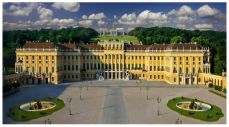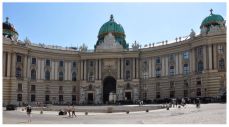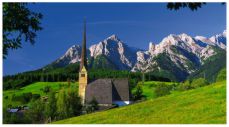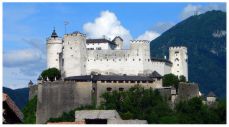Glorious Alpine scenery, monumental Habsburg architecture, and the world’s favourite musical – Austria’s tourist industry certainly plays up to the clichés. However, it’s not all bewigged Mozart ensembles and schnitzel; modern Austria boasts some of Europe’s most varied museums and contemporary architecture not to mention attractive and sophisticated cities whose bars, cafés and clubs combine contemporary cool with elegant tradition. Long the powerhouse of the Habsburg Empire, Austria underwent decades of change and uncertainty in the early twentieth century. Shorn of her empire and racked by economic difficulties, the state fell prey to the promises of Nazi Germany. Only with the end of the Cold War did Austria return to the heart of Europe, joining the EU in 1995. Politics aside, Austria is primarily known for two contrasting attractions – the fading imperial glories of the capital, and the stunning beauty of its Alpine hinterland. Vienna is the gateway to much of central Europe and a good place to soak up the culture of Mitteleuropa. Less renowned provincial capitals such as Graz and Linz are surprising pockets of culture, innovation and vitality. Salzburg, between Innsbruck and Vienna, represents urban Austria at its most picturesque, an intoxicating Baroque city within easy striking distance of the mountains and lakes of the Salzkammergut, while the most dramatic of Austria’s Alpine scenery is west of here, in and around Tyrol, whose capital, Innsbruck, provides the best base for exploration.
At a Glance
PLAN YOUR TOUR
3 Days:Vienna 5 Days Salzburg 7 Days, add: Hallstatt 10 Days, add:Danube Valley, Tirol, and Bavaria 14 Days, add:Innsbruck, Hall, and day trip to Bratislava 16 Days, add:More time in Vienna
With More Time:
Depending on your interests, you could easily spend several more days in Vienna (for museums, the music scene, going to cafés and wine gardens, day-tripping to Bratislava) and a couple more days in Salzburg (for the music scene, nearby sights, day-tripping to Berchtesgaden). The countryside of southern Bavaria and western Tirol are great places to linger and explore (consider a day or two of car rental).
Things To Do:
*Vienna Austria's regal capital city, rich with swirling architecture and world-class museums; impressive Habsburg sights (Schönbrunn Palace, in-city royal apartments, treasury, crypt, and Lipizzaner stallions); massive St. Stephen's Cathedral; and a grand classical-music tradition, from its renowned Opera house to its famous Boys' Choir.
* Western Tirol and Southern Bavaria (Germany) Pair of Alps-straddling regions boasting the fairy-tale castles of Neuschwanstein, Hohenschwangau, and Linderhof; inviting villages such as the Austrian retreat of Reutte and German towns of Füssen and Oberammergau; the towering Zugspitze and its high-altitude lifts; and hiking, luge, and other mountain activities.
* Salzburg Austrian musical mecca for fans of Mozart and The Sound of Music, offering a dramatic castle, Baroque churches, near-nightly concerts, and an old town full of winding lanes.
* Hallstatt and the Salzkammergut Scenic lake district, home to the halcyon village of Hallstatt, with its medieval town center, fun salt mine, plentiful hiking opportunities, and placid swan-filled lake.
* Heart of Tirol Austria's panhandle region and mountain-sports capital, centering around the distinctive city of Innsbruck and little neighboring Hall, with its quaint and colorful old town.
* Danube Valley Romantic, bikeable valley west of Vienna, dotted with ruined castles, adorable villages and vineyards, and highlighted by the glorious Melk Abbey and somber Mauthausen concentration-camp memorial.
* Bratislava (Slovakia) Once-depressed communist town, now a thriving capital city, less than an hour from Vienna and bursting with colorfully restored buildings; a quirky traffic-free old town; and a people-friendly Danube riverfront area.
* Berchtesgaden (Germany) Alpine town across the border from Salzburg, famous for incredible views, a pristine lake — and as the site of Hitler's mountaintop retreat.
When to Go
The "tourist season" runs roughly from May through September. Summer has its advantages: best weather, snow-free alpine trails, very long days (light until after 21:00), and the busiest schedule of tourist fun. Travel during "shoulder season" (late April–June and Sept–early Oct) is easier and a bit less expensive. Shoulder-season travelers get minimal crowds, decent weather, the full range of sights and tourist fun spots, and the ability to grab a room almost whenever and wherever they like — often at a flexible price. Also, in fall, fun harvest and wine festivals enliven many towns and villages, while forests and vineyards display beautiful colors. Winter travelers find concert seasons in full swing, with absolutely no tourist crowds, but some accommodations and sights are either closed or run on a limited schedule. Confirm your sightseeing plans locally, especially when traveling off-season. The weather can be cold and dreary, and nightfall draws the shades on sightseeing well before dinnertime. But dustings of snow turn Austrian towns and landscapes into a wonderland, and December offers the chance to wander through traditional Christmas markets.






